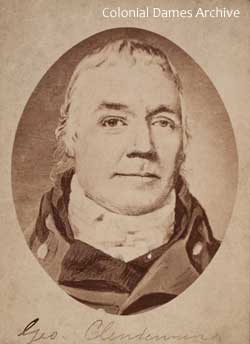Sundial Project
In 1917 the National Society of Colonial Dames of America in the State of West Virginia established a marker to pay tribute to the pioneer Clendenin family of Charleston, West Virginia. Charles Clendenin, his sons, and the Virginia Rangers built Fort Clendenin in 1788, a frontier outpost that protected settlers from Indian attacks. The Clendenin Fort was officially called Fort Lee in honor of Henry “Lighthourse” Lee, governor of Virginia and father of Robert E. Lee.
 Colonial Dames past presidents Sue McKinney, Kit Wellford, and Tate Hudson watch over the 2013 restored Sun Dial monument created in 1917 to pay tribute to the pioneers who risked their lives to settle the wilderness in western Virginia, now Charleston, West Virginia. Mary Jane Vanderveilt, City Board member who supported historical monuments for the Kanawha Valley, joined the group. Charles Clendenin died within the fort built close to this spot on the banks of the great Kanawha River. His son, George Clendenin, named Charleston for his father. George Clendenin is pictured below. Photographer: Chip Ellis, Charleston Sunday Gazette-Mail
Colonial Dames past presidents Sue McKinney, Kit Wellford, and Tate Hudson watch over the 2013 restored Sun Dial monument created in 1917 to pay tribute to the pioneers who risked their lives to settle the wilderness in western Virginia, now Charleston, West Virginia. Mary Jane Vanderveilt, City Board member who supported historical monuments for the Kanawha Valley, joined the group. Charles Clendenin died within the fort built close to this spot on the banks of the great Kanawha River. His son, George Clendenin, named Charleston for his father. George Clendenin is pictured below. Photographer: Chip Ellis, Charleston Sunday Gazette-Mail
The Sundial marker and commemorative plaque were placed along the Kanawha River in the 1200 block. This monument was the first of seven Colonial Dames’ monuments paying tribute to the patriots who risked their lives to settle the land in western Virginia. The sundial is on a marble pedestal surrounded by a black wrought-iron fence. A bronze plaque at the site reads: Erected in 1917/ By the Colonial Dames of West Virginia/In Memory of Charles Clendendin /For Whom Charleston Was Named/December 1794.
The Clendenin family, originally from Scotland, moved from the Shenandoah Valley to settle in the wild frontier of the Kanawha Valley in the 1780s. In a 1911 history of Charleston, members of the Clendenin family were called “good citizens and community builders.”
George Clendenin, one of four sons, purchased 1,040 acres of land and named the town “Charles Town” after his father who served in the Virginia legislature. After the two-story log fort was built, a court house was soon established inside the fort with log cabins constructed outside. In future years, this colonial Kanawha Valley village would become the capital of West Virginia and the state’s biggest city.
Charles Clendenin was the first person to die within the fort in 1790; he was buried in a garden within the stockade. Son George took his father’s place in the legislature from 1790-1795. In 1795 Charles sold the Clendenin land to Joseph Ruffner whose family became actively involved in the future growth of the town that would be renamed “Charleston” in 1818.

 *A commemorative sign along the Kanawha River in downtown Charleston cites son George Clendenin as the founder of Charleston.
*A commemorative sign along the Kanawha River in downtown Charleston cites son George Clendenin as the founder of Charleston.
The Sundial monument has been vandalized numerous times since 1917. A 2012 restoration was made possible with the joint effort of NSCDA-West Virginia, the Charleston Beautification Commission, and the Charleston Public Works Department.
The practice of erecting markers was discontinued by the Colonial Dames of West Virginia when the state of West Virginia placed markers of uniform type at all points of historic interest along the highways.
Sources:
History of Charleston and Kanawha County, West Virginia and Representative Citizens (1911) Archives & History Library, Charleston, West Virginia
“Founding of Charleston, West Virginia” http://www.wvencyclopedia.org/articles/1089
“Clendenin Family” http://www.wvencyclopedia.org/articles/1303
“George Clendenin” http://www.wvencyclopedia.org/articles/1305
